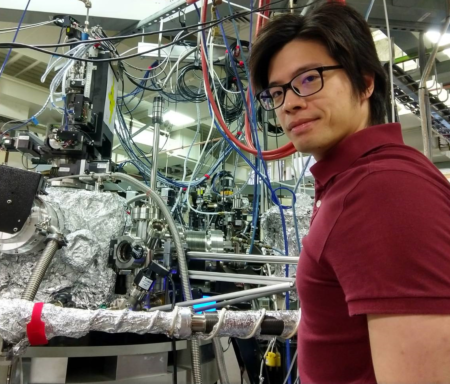 Where were you before you came to the Advanced Light Source?
Where were you before you came to the Advanced Light Source?
When I was a master’s student at Tamkang University in Taiwan, I studied materials synthesis. Then, I served in the army for a year. When I started my PhD, I split my time between Tamkang University and the National Synchrotron Radiation Research Center in Hsinchu, Taiwan. My supervisor, Way-Faung Pong, is a long-term collaborator of Jinghua Guo, so he sent me here as an exchange student from 2013 to 2015. I then went back to Taiwan to finish up my PhD.
Tamkang is a really good place with many night markets. Because it’s near the sea, you can smell salt in the air and see beautiful sunsets.
How did you become interested in synchrotron research?
I started my research in materials synthesis, but I felt that I wasn’t too handy with synthesis work. However, during that time, I saw that synchrotron-related techniques were a tool for observing key microscopic interactions in materials. The techniques are capable of observing the intrinsic behavior of materials phenomena, though I think it’s also not easy to analyze synchrotron-based data. But, when I found out how hard the analysis was, I was already here!
My project from 2013 to 2015 was part of a collaboration between Taiwan and the Advanced Light Source. The collaboration was on RIXS instrumentation, and I found that to be very useful for the topic I was studying, but in Taiwan, the RIXS instrumentation was still under commissioning, so that’s why I came here and worked with Jinghua Guo. During those two years, I performed RIXS experiments on fullerenes to understand the properties that make them good candidates for MRI contrast agents. I was able to take the spectrometer I helped develop back to the Taiwan Photon Source, and then spent a year working on the endstation there.
What are you researching at the ALS?
I’m an ALS collaborative postdoctoral fellow, so my supervisor is Byron Freelon at the University of Louisville, and I work with Yi-De Chuang on Beamline 8.0.1 at the ALS. It’s the qRIXS endstation and is 200–1,000 eV, which is ideal for detecting microscopic interactions in transition metal oxides.
I’ve spent some time collaborating with users and discussing their work, but I also have my own project. I’m working on ruthenate and nickelate using qRIXS, and Yi-De is the expert on this method. I’m taking measurements, doing analysis, and we will do theoretical calculations about these two systems. I expect to find spin, orbital, and charge transfer excitations using RIXS in these two systems. Because they’re strongly correlated systems, their characteristics can be tunable. Understanding the complex coupling in this kind of system will be helpful for the next generation of electronic devices, like computers, cell phones, and sensors.
For my next step, I’d like to learn theoretical computation methods that will help us analyze the RIXS data from our samples; that will exactly and concretely describe the phenomena in microscopic interactions. That’s what I’m trying to learn while I’m here.
What do you like to do in your free time?
Life in the Bay Area is really good! Compared with Kentucky, the weather here is better. In Kentucky, it’s really cold right now, but the whiskey is good.The Bay Area is sunny and comfortable—I love it here! The only downside to the weather in the Bay Area is that I won’t be as used to the weather back in Taiwan! I like to go hiking and try new foods. I enjoy the restaurants—Thai, Korean, Japanese; there’s a lot of Asian food in the area.